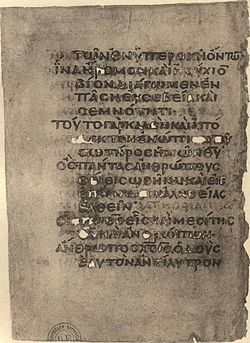

| 1 Timothy 4 | |
|---|---|
 Fragments showing 1 Timothy 2:2–6 on Codex Coislinianus, from ca. AD 550. | |
| Book | First Epistle to Timothy |
| Category | Pauline epistles |
| Christian Bible part | New Testament |
| Order in the Christian part | 15 |
1 Timothy 4 is the fourth chapter of the First Epistle to Timothy in the New Testament of the Christian Bible. The author has been traditionally identified as Paul the Apostle since as early as AD 180,[1][2][3] although most modern scholars consider the letter pseudepigraphical,[4] perhaps written as late as the first half of the second century AD.[5]
This chapter deals with future false teachers (verses 1-6), giving directions to Timothy in reference to them (verses 7-11), and concludes with further general exhortations to Timothy (verses 12-16).[6]

The original text was written in Koine Greek. This chapter is divided into 16 verses.
Some early manuscripts containing the text of this chapter are:
Some writers suggest that the Dead Sea Scrolls contain fragments of Timothy and other Christian Greek scriptures (such as that 7Q4 contains verses 4:1–3), but this view is rejected by the majority of scholars.[9][10][11][12]
The Greek ἐν ὑστέροις καιροῖς (en husterois kairois) is translated as "latter times" in the King James Version and some other translations. Others refer to "later times".[14] Commentator Henry Alford argues that the writer here "speaks only of times subsequent to those in which he was writing" and warns that the words should not be read with the "last times" in mind.[6]